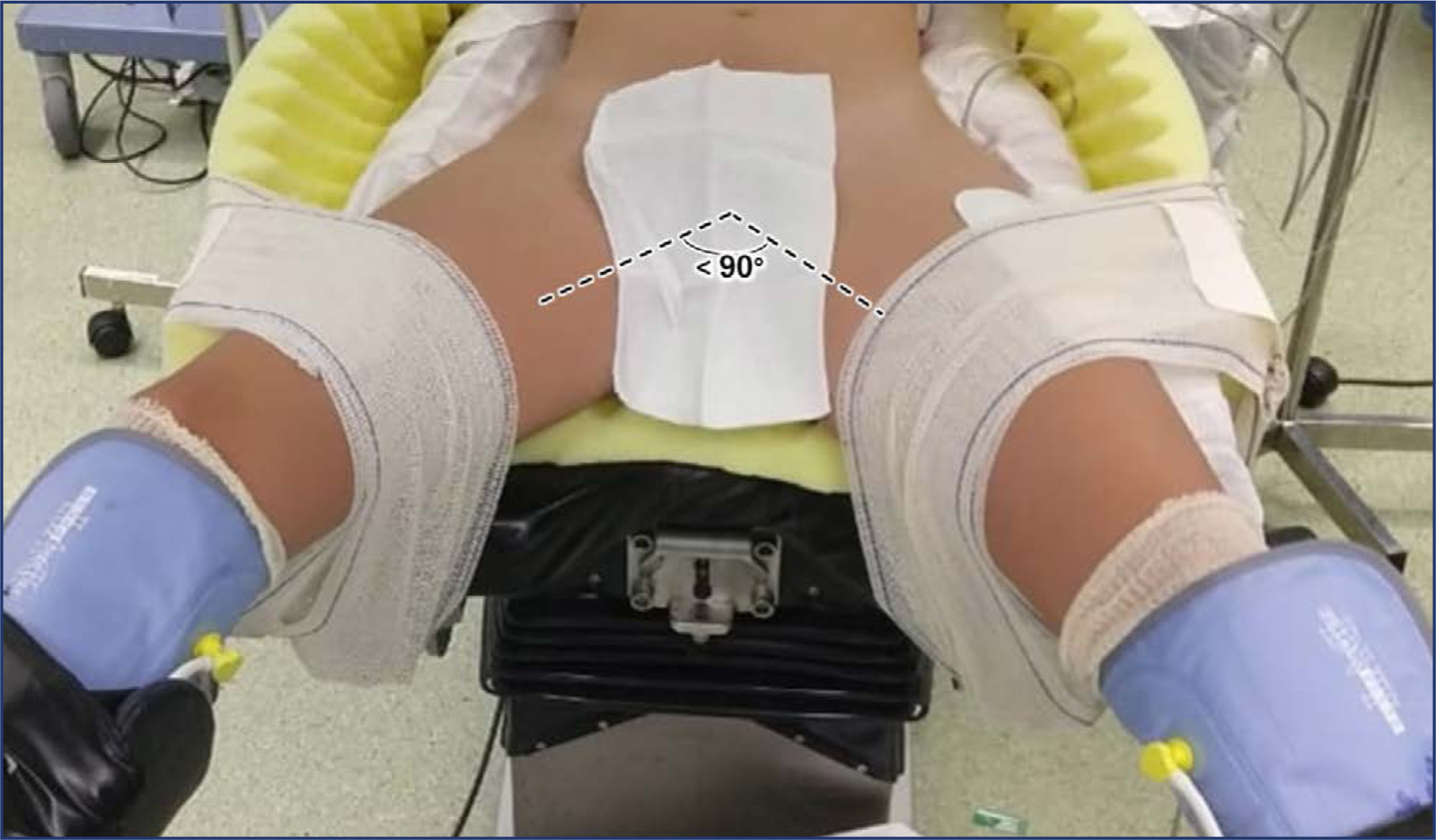Summary
Revista Brasileira de Ginecologia e Obstetrícia. 2024;46:e-rbgo46
Effective patient positioning is a critical factor influencing surgical outcomes, mainly in minimally invasive gynecologic surgery (MIGS) where precise positioning facilitates optimal access to the surgical field. This paper provides a comprehensive exploration of the significance of strategic patient placement in MIGS, emphasizing its role in preventing intraoperative injuries and enhancing overall surgical success. The manuscript addresses potential complications arising from suboptimal positioning and highlights the essential key points for appropriate patient positioning during MIGS, encompassing what the surgical team should or shouldn't do. In this perspective, the risk factors associated with nerve injuries, sliding, compartment syndrome, and pressure ulcers are outlined to guide clinical practice. Overall, this paper underscores the critical role of precise patient positioning in achieving successful MIGS procedures and highlights key principles for the gynecological team to ensure optimal patient outcomes.

Summary
Revista Brasileira de Ginecologia e Obstetrícia. 2022;44(2):133-141
To investigate the prevalence of premenstrual syndrome (PMS) and premenstrual dysphoric disorder (PMDD) in university students, the factors associated with PMS, the most prevalent symptoms, and the interference of symptoms in academic, family, social, and work activities.
This cross-sectional study included 1,115 university students aged ≥ 18 years from the University of Rio Verde, Goiás. Premenstrual syndrome and PMDD were identified using the Premenstrual Symptoms Screening Tool. Associations with sociodemographic, behavioral, reproductive, nutritional, and health factors were investigated using the Poisson regression.
The prevalence of PMS was 46.9% (95% confidence interval [CI] 44.0-49.8), and of PMDD, 11.1% (95% CI 9.3-13.0). The most prevalent symptoms were physical, such as breast tenderness, bloating, e weight gain (73%); followed by psychological ones such as overeating/food cravings, tearful/more sensitive to rejection (> 60%). More than 30% of the patients reported that the symptoms interfered in a moderate-tosevere way in their social and academic activities. After adjusted analysis, PMS was more prevalent in those who were attending the 1st/2nd semester of college (prevalence ratio [PR] 1.44; 95% CI 1.14-1.80), those who consumed alcohol in the last 30 days (PR 1.23; 95% CI 1.04-1.47), and those who had depression (PR 1.49; 95% CI 1.30-1.71).
Almost half of the university students had PMS and ~ 11%, PMDD. Physical symptoms were themost common and interfered in amoderate-to-severe way in various aspects of life. Attending the first semesters, consuming alcohol, and having depression were risk factors for PMS. The identification of risk factors for PMS is essential to prevent symptoms and reduce the impact of the syndrome.
Summary
Revista Brasileira de Ginecologia e Obstetrícia. 2022;44(5):452-457
To detect depression during pregnancy and in the immediate postpartum period using the Edinburgh postpartum depression scale (EPDS).
Cross sectional study of 315 women, aged between 14 and 44 years, who received perinatal care at the Leonor Mendes de Barros Hospital, in São Paulo, between July 1st, 2019 and October 30th, 2020. The cutoff point suggesting depression was ≥ 12.
The screening indicated 62 (19.7%) patients experiencing depression. Low family income, multiparity, fewer prenatal appointments, antecedents of emotional disorders, dissatisfaction with the pregnancy, poor relationship with the partner, and psychological aggression were all risk factors associated with depression in pregnancy or in the immediate postpartum period. Antecedents of depression and psychology aggression during pregnancy were significant variables for predicting perinatal depression in the multivariate analysis.
There is a significant association between the occurrence of perinatal depression and the aforementioned psychosocial factors. Screening patients with the EPDS during perinatal and postpartum care could facilitate establishing a line of care to improve the wellbeing of mother and infant.
Summary
Revista Brasileira de Ginecologia e Obstetrícia. 2021;43(6):436-441
The aim of the present study was to evaluate the risk factors for cesarean section (C-section) in low-risk multiparous women with a history of vaginal birth.
The present retrospective study included low-risk multiparous women with a history of vaginal birth who gave birth at between 37 and 42 gestational weeks. The subjects were divided into 2 groups according to the mode of delivery, as C-section Group and vaginal delivery Group. Risk factors for C-section such as demographic characteristics, ultrasonographic measurements, smoking, weight gain during pregnancy (WGDP), interval time between prior birth, history of macrosomic birth, and cervical dilatation at the admission to the hospital were obtained fromthe charts of the patients. Obstetric and neonatal outcomes were compared between groups.
The most common C-section indications were fetal distress and macrosomia (33.9% [n=77 and 20.7% [n=47] respectively). A bivariate correlation analysis demonstrated that mothers aged>30 years old (odds ratio [OR]: 2.09; 95% confidence interval [CI]: 1.30-3.34; p=0.002), parity >1 (OR: 1.81; 95%CI: 1.18-2.71; p=0.006), fetal abdominal circumference (FAC) measurement>360mm (OR: 34.20; 95%CI: 8.04 -145.56; p<0.001)) and<345mm (OR: 3.06; 95%CI: 1.88-5; p<0.001), presence of large for gestational age (LGA) fetus (OR: 5.09; 95%CI: 1.35-19.21; p=0.016), premature rupture of membranes (PROM) (OR: 1.52; 95%CI: 1-2.33; p=0.041), and cervical dilatation<5cm at admission (OR: 2.12; 95%CI: 1.34-3.34; p=0.001) were associated with the group requiring a C-section.
This is the first study evaluating the risk factors for C-section in low-risk multiparous women with a history of vaginal birth according to the Robson classification 3 and 4. Fetal distress and suspected fetal macrosomia constituted most of the Csection indications.
Summary
Revista Brasileira de Ginecologia e Obstetrícia. 2021;43(2):113-118
To identify risk factors related to postpartum hemorrhage (PPH) and severe PPH with blood loss quantified objectively.
This is a complementary analysis of a prospective cohort study that included pregnant women delivering vaginally. The total blood loss was obtained through the sum of the volume collected from the drape with the weight of gauzes, compresses and pads used by women within 2 hours. Exploratory data analysis was performed to assess mean, standard deviation (SD), frequency, percentage and percentiles. The risk factors for postpartum bleeding were evaluated using linear and logistic regression.
We included 270 women. Themean blood loss at 120 minutes was 427.49 mL (±335.57 mL). Thirty-one percent (84 women) bled > 500mL and 8.2% (22 women) bled > 1,000 mL within 2 hours. Episiotomy, longer second stage of labor and forceps delivery were related to blood loss > 500mL within 2 hours, in the univariate analysis. In the multivariate analysis, only forceps remained associated with bleeding > 500 mL within 2 hours (odds ratio [OR] = 9.5 [2.85-31.53]). Previous anemia and episiotomy were also related to blood loss > 1,000mL.
Prolonged second stage of labor, forceps and episiotomy are related to increased incidence of PPH, and should be used as an alert for the delivery assistants for early recognition and prompt treatment for PPH.

Summary
Revista Brasileira de Ginecologia e Obstetrícia. 2020;42(8):454-459
Streptococcus agalactiae is an important pathogen in neonates and pregnant women. Neonatal invasive infections due to S. agalactiae are life-threatening and preventive strategies for this challenge of human have become a concern. The aim of the present study was to determine the prevalence of rectovaginal colonization, related risk factors and antibiotic resistance pattern of S. agalactiae among pregnant women in Iran.
The present study was performed on 240 pregnant women. Vaginal and rectal swabs were obtained from all of the women and then were transferred to the laboratory. The isolation and identification of S. agalactiae was performed by standard microbiological tests and polymerase chain reaction (PCR) assay. The antimicrobial susceptibility patterns of the isolates were determined by the Kirby-Bauer disk diffusion. Polymerase chain reaction was used to detect ermB and mefA genes in erythromycin-nonsusceptible isolates.
Out of 240 pregnant women, 16 cases (6.7%) were colonized by S. agalactiae. There is no significant association between demographic-obstetric factors and maternal S. agalactiae colonization in the pregnant women. Linezolid, vancomycin and ampicillin were the most effective antibiotics against S. agalactiae. The ermB gene was present in 6 (35.29%) S. agalactiae isolates. However, the mefA gene was not detected in any of the isolates.
Given the relatively significant prevalence of S. agalactiae colonization in the pregnant women in the present study and the risk of serious neonatal infections, the screening of pregnant mothers for the bacteria seems necessary. Our findings highlight the importance of appropriate antibiotic prophylaxis during pregnancy for the prevention of early onset S. agalactiae-neonatal infection and comorbidity.
Summary
Revista Brasileira de Ginecologia e Obstetrícia. 2020;42(4):188-193
To evaluate the frequency of structural congenital anomalies (CAs) in the midwest of Brazil and its association with maternal risk factors.
This was a prospective, observational, case-control study based on a hospital population. Pregnant women attended at a fetal medicine service in Brazil were analyzed in the period from October 2014 to February 2016.A total of 357 pregnant women were included, 223 of whom had fetuses with structural anomalies (group case), and 134 of whom had structurally normal fetuses (control group). The clinical history was made previous to prenatal consultation, and the diagnosis of the structural CA was performed through ultrasound.
A frequency of 64.27% (n = 223) of pregnant women with fetuses with structural anomalies was observed. The most frequent structural CAs were those of the central nervous system (30.94%), followed by anomalies of the genitourinary system (23.80%), and, finally, by multiple CAs (16.60%). The background of previous children with CAs (odds ratio [OR]: 3.85; p = 0.022), family history (OR: 6.03; p = < 0.001), and consanguinity between the progenitors (OR: 4.43; p = 0.034) influenced the occurrence of structural CA.
The most frequent CAs are those of the central nervous system, followed by those of the genitourinary system, and then multiple anomalies. The maternal risk factors that may have influenced the occurrence of structural CA were previous children with CA, family history, and consanguinity among the parents.